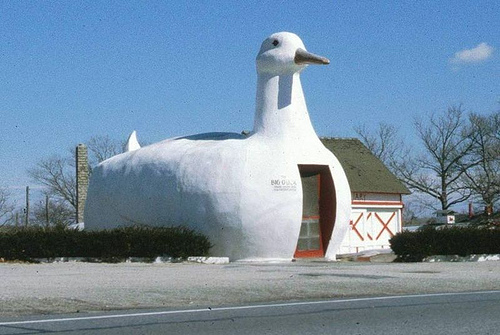
Okay, the new shop has to promote our duck farm somehow! Everybody, think!
Martin Maurer’s painfully literal solution has graced Long Island since 1931. To this day, buildings shaped like recognizable objects are called “ducks.”

Okay, the new shop has to promote our duck farm somehow! Everybody, think!
Martin Maurer’s painfully literal solution has graced Long Island since 1931. To this day, buildings shaped like recognizable objects are called “ducks.”
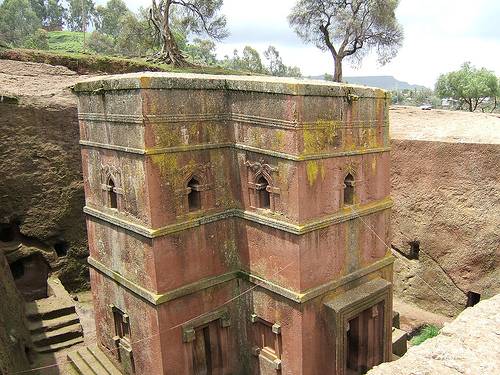
The Church of St. George in Lalibela, Ethiopia, was cut from a single block of stone in the 12th century.
See also Rock-Cut Architecture.
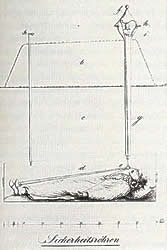
Johann Taberger designed this “safety coffin” in 1829, to preserve people who had been mistakenly buried alive. Strings were attached to the body’s head, hands, and feet, connected to a bell that would alert the cemetery’s nightwatchman, who could use a bellows to pump air into the coffin until it could be dug up.
Such devices were popular during the cholera epidemics of the 18th and 19th centuries — European graves were rigged variously with bells, flags, ladders, and escape hatches. There’s no evidence that they ever saved anyone, and they nearly killed some of their inventors: During a demonstration in 1897, a chamberlain to the tsar of Russia buried his assistant, waited, and finally realized that the signaling system had failed. The assistant was saved, but the marketing campaign was DOA.
On St. Joseph’s Day, 1678, on the mountains called La Langhe, there fell, on the white snow, that lay there before, a great quantity of red, or if you please, of bloody snow. From which, being squeezed, there came a water of the same colour. Communicated by Sig. Sarotti, the Venetian Resident there, to Mr. Boyle.
— Philosophical Transactions, 1678
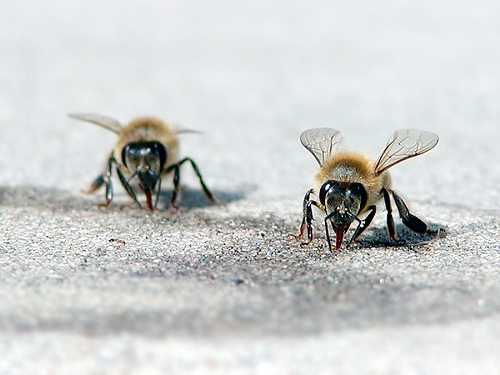
An extraordinary discovery in Natural History was made at Liverpool about a fortnight ago. As one of the stonemasons in the employ of the Dock Trustees, was dressing, on the sea wall of the Regent’s Dock, a huge stone, brought from the Western Point Quarry, and after he had broken a considerable thickness from its outside, he discovered, in a hole of small diameter, which was partially filled with clay, and a loamy sand, three bees, in a state of animation, to the inexpressible astonishment of himself and fellow-workmen, many of whom were witnesses of this strange phenomenon. The foreman of the works put them into his handkerchief, where they remained for several hours afterwards; but, while exhibiting his newly resuscitated strangers, two of them flew away, and he voluntarily gave the third its liberty.
— Liverpool Advertiser, Nov. 24, 1817
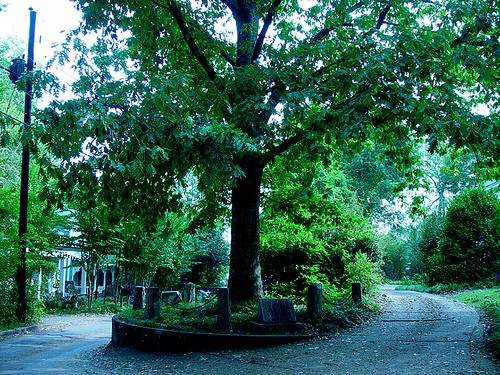
In 1832, Col. William Henry Jackson of Athens, Ga., made an unusual bequest:
I, W. H. Jackson, of the county of Clarke, of the one part, and the oak tree … of the county of Clarke, of the other part: Witnesseth, That the said W. H. Jackson for and in consideration of the great affection which he bears said tree, and his great desire to see it protected has conveyed, and by these presents do convey unto the said oak tree entire possession of itself and of all land within eight feet of it on all sides.
So goes the legend. Legally the land is probably part of the right-of-way along Finley Street, but Jackson’s wishes have been honored in spirit: When the original tree fell in 1942, the townspeople grew a replacement from one of its acorns.
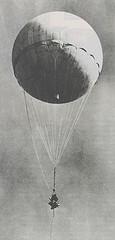
In early 1945, Americans in western states began to notice something odd. Explosions were heard from Alaska to California, and some people reported seeing parachutes and balloons in the sky.
Newsweek ran an article titled “Balloon Mystery” but was soon contacted by the U.S. Office of Censorship, which was trying to keep the story quiet. It seems the Japanese were using balloons to float bombs over the continental United States. At first it was thought the balloons were being launched from North American beaches, but scientists who studied the sand in their sandbags eventually determined they had been launched from Japan itself. The jet stream could carry a high-altitude balloon across the Pacific in three days.
Japan, it turned out, had launched more than 900 such balloons, and 300 have been found in America. The censorship prevented any word of success from reaching Japan, so the project was soon discontinued. But there was, sadly, some success: On May 5, 1945, a 13-year-old girl tried to pull a balloon from a tree during a church picnic. It exploded, killing a woman and five children.
March 20, 1759, Mr. Haynes, a carpenter, in St John’s-street, was seized with a giddiness. While his wife was employed in rubbing the part affected, his hair came off from his head and his eye-brows. The same accident happened some years before to Mr. Stanley, of St. Andrew’s, Holborn.
— Annual Register, 1759
Physicist James Van Allen outlived his own obituary writer.
As Van Allen approached old age, the Associated Press assigned writer Walter Sullivan to prepare a story that could be published on his death. Sullivan did so and died in 1996, but his story sat in the file for 10 more years before Van Allen finally passed away at 91.
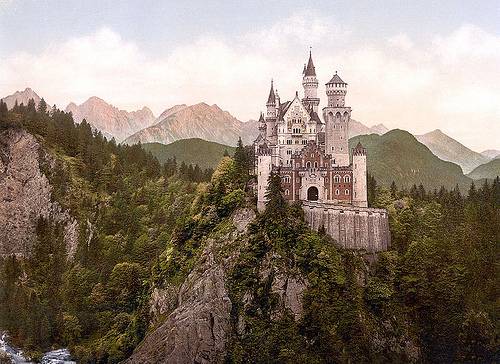
On the evening of June 13, 1886, King Ludwig II of Bavaria went for a walk with a friend on Lake Starnberg. The two never returned, and were found dead in shallow water at 11:30 p.m. Ludwig was known to be a good swimmer, and there was no water in his lungs. Was he assassinated? No one knows.